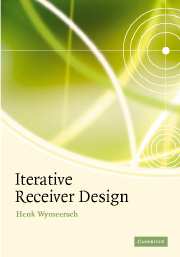Book contents
- Frontmatter
- Contents
- Preface
- Abbreviations
- Notations
- List of algorithms
- 1 Introduction
- 2 Digital communication
- 3 Estimation theory and Monte Carlo techniques
- 4 Factor graphs and the sum–product algorithm
- 5 Statistical inference using factor graphs
- 6 State-space models
- 7 Factor graphs in digital communication
- 8 Decoding
- 9 Demapping
- 10 Equalization–general formulation
- 11 Equalization: single-user, single-antenna communication
- 12 Equalization: multi-antenna communication
- 13 Equalization: multi-user communication
- 14 Synchronization and channel estimation
- 15 Appendices
- References
- Index
7 - Factor graphs in digital communication
Published online by Cambridge University Press: 08 January 2010
- Frontmatter
- Contents
- Preface
- Abbreviations
- Notations
- List of algorithms
- 1 Introduction
- 2 Digital communication
- 3 Estimation theory and Monte Carlo techniques
- 4 Factor graphs and the sum–product algorithm
- 5 Statistical inference using factor graphs
- 6 State-space models
- 7 Factor graphs in digital communication
- 8 Decoding
- 9 Demapping
- 10 Equalization–general formulation
- 11 Equalization: single-user, single-antenna communication
- 12 Equalization: multi-antenna communication
- 13 Equalization: multi-user communication
- 14 Synchronization and channel estimation
- 15 Appendices
- References
- Index
Summary
Introduction
Let us now return to our original problem from Chapter 2: receiver design. Our ultimate goal is to recover (in an optimal manner) the transmitted information bits b from the received waveform r(t). In this chapter, we will formulate an inference problem that will enable us to achieve this task. In the first stage the received waveform is converted into a suitable observation y.We then create a factor graph of the distribution p(B, Y = y|M). This factor graph will contain three important nodes, expressing the relationship between information bits and coded bits (the decoding node), between coded bits and coded symbols (the demapping node), and between coded symbols and the observation (the equalization node). Correspondingly, the inference problem breaks down into three sub-problems: decoding, demapping, and equalization.
Decoding will be covered in Chapter 8, where we will describe some state-of-the-art iterative decoding take over schemes, including turbo codes, RA codes, and LDPC codes. The demapping problem will be considered in Chapter 9 for two common modulation techniques: bit-interleaved coded modulation and trellis-coded modulation. Equalization highly depends on the specific digital communication scheme. In Chapter 10, we will derive several general-purpose equalization strategies. In the three subsequent chapters, we will then show how these general-purpose strategies can be applied to the digital communication schemes from Chapter 2. In Chapter 11 the focus is on single-user, single-antenna communication.
- Type
- Chapter
- Information
- Iterative Receiver Design , pp. 135 - 142Publisher: Cambridge University PressPrint publication year: 2007



